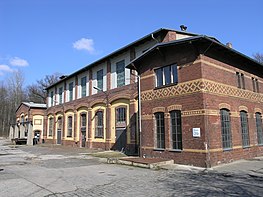Kesselhaus (Berlin-Lichtenberg)
The Kesselhaus ( since 2003 Museum Kesselhaus Herzberge ) is a late Classicist brick building , part of an ensemble and is located on the grounds of the Evangelical Hospital Queen Elisabeth Herzberge (KEH) in the Berlin district of Lichtenberg in the Lichtenberg district .
history
The boiler house was built together with the other buildings on the hospital grounds between the years 1889 and 1893 by the architect Hermann Blankenstein . It consists of three building parts arranged at right angles to one another, which are made of dark red imperial format bricks with ocher yellow ornamental stripes. The two 46-meter-high chimneys are also made of dark red imperial format bricks with yellow ocher stripes.
Because of the technical requirements, the use of the north and south buildings of the house changed steadily differently than the boiler house. The southern part of the house served as a workshop and living area, with the power supply by means of dynamos and the accumulators initially being housed in the northern building. In 1925 the hospital premises were connected to the then public electricity supplier. A water treatment system has been built in the northern part of the building, which supplies the hospital grounds with water via deep wells.
After the Second World War , extensive renovation work was carried out on the technology in the boiler house. The ten double-flame tube boilers from the Borsig company for generating water vapor for heating and powering the hospital system were located in the middle of the boiler house between 1892 and 1951. Four steam boilers were removed from the former Reich Chancellery. After the renovation, they were reinstalled in the northern part of the boiler room and went into operation in 1951. Ten years later, two small-tube boilers for more efficient steam generation were added to meet the increasing demand. In 1986 the hospital grounds were connected to the local district heating network. The last boilers had to stop operating in the early 1990s due to technical defects. The two 55 meter high chimneys were demolished in 1984 and 1990 due to construction defects.
Between the years 2000 and 2003 there was a careful reconstruction of the facade, a conservation of the remaining boiler and a new usage concept was decided. In 2001 the association Museum Kesselhaus e. V. founded, which accompanied the renovation work. There was a true-to-original replica of the industrial glazing for reasons of thermal insulation on the inside using simple steel frames, the installation of two additional stairs as escape routes, the preservation of the steam boiler system, the dismantling of non-listed additions and modifications and the renovation and cleaning of the brick masonry inside and outside. The measures were funded by the Berlin State Monument Office , the German Foundation for Monument Protection , the special program Dach und Fach, the Berlin Central Employment Office and through donations from private sponsors and friends of the project. After the renovation work, the house was officially opened on the Open Monument Day in 2003 as the Museum Kesselhaus Herzberge. In addition, the theater hall can be used, there is a medical history library as well as reading and work rooms. There is also an exhibition room and documentation of the hospital history, an archive of psychiatric medical files for university use, a break room, kitchen and sanitary facilities.
Individual evidence
- ↑ a b Kesselhaus Museum. Retrieved January 23, 2020 .
- ↑ a b c d e District Office Lichtenberg, Lower Monument Protection Authority (ed.): Preservation of monuments in the Lichtenberg district . 2006, p. 7-9 .
- ^ List, map, database / Landesdenkmalamt Berlin. Retrieved January 22, 2020 .
Coordinates: 52 ° 31 ′ 40.2 " N , 13 ° 30 ′ 43.4" E
